Hemp Bales
Tour Stop
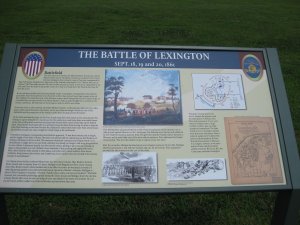 Directions: The stop for the Hemp Bales [ Waypoint = N39 11.522 W93 52.761 ] is located on the Lexington Battlefield at the north end of 15th Street, Lexington Missouri 64067. There is limited parking at the battlefield entrance.
Directions: The stop for the Hemp Bales [ Waypoint = N39 11.522 W93 52.761 ] is located on the Lexington Battlefield at the north end of 15th Street, Lexington Missouri 64067. There is limited parking at the battlefield entrance.
From the Scene of Hand-to-Hand Combat continue walking south along the battlefield trail about 75 yards until you reach the next open area downhil to the west. Take a moment to read the "Battlefield" interpretive sign [ Waypoint = N39 11.529 W93 52.740 ].
Description: On the second day of the battle, someone came up with the idea to use the large hemp bales stored in the warehouses by the river as "movable breastworks". The idea was for the Missouri State Guardsmen to roll the hemp bales up the hill and to fire at the Federals from behind the hemp bales. At first they soaked the bales in the Missouri River to prevent them being set on fire by heated shot from the Federal artillery. But the wet bales proved to be too heavy to roll up the hill and they settled for using dry ones. The hemp bales were used on the west side of the battlefield to cover the approach to the Anderson House and for about 200 yards north of that point.
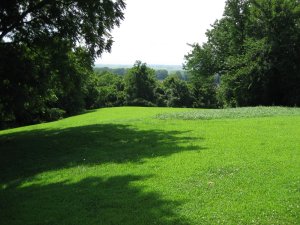 |
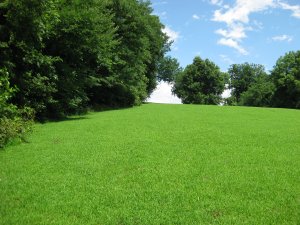 |
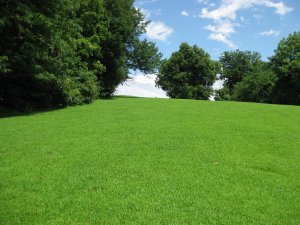 |
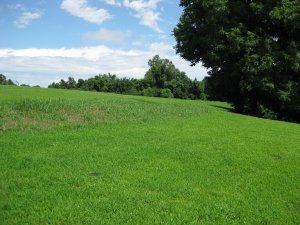 |
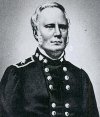 In his official report of the battle, Major General Sterling Price describes using the hemp bales as movable breastworks.
In his official report of the battle, Major General Sterling Price describes using the hemp bales as movable breastworks.
"On the morning of the 20th instant I caused a number of hemp bales to be transported to the river heights, where moveable breast-works were speedily constructed out of them by Gens. Harris and McBride, Col. Rives, Maj. Winston, and their respective commands."
In his official report of the battle, 2nd Division commander Brigadier General Thomas A. Harris wrote about the use of the hemp bales. He initially began using the hemp bales on September 19th and extended the use of them on September 20th.
"I then directed Capt. George A. Turner, of my staff, to request of you [General Price] one hundred and thirty-two bales of hemp, which you promptly accorded. Capt. Turner was intrusted with the general superintendence of transporting it to the points designated. ... I directed the bales to be wet in the river to protect them against the casualties of fire of our troops and of the enemy, but it was soon found that the wetting so materially increased the weight as to prevent our men in their exhausted condition from rolling them to the crest of the hill. I then adopted the idea of wetting the hemp after it had been transported to its position. In the arduous and extremely trying duty of transporting the hemp.
"At 8:00 o'clock a. m. on the 20th inst., I ordered up additional hemp to extend the defenses. ... I directed them to be used as portable breast-works, to be pushed forward towards the enemy's lines in parallel approaches. The disclosure of the hemp defenses, or approaches as they might be called, elicited the obstinate resentment of the enemy, who was profuse in the bestowal of round and grape shot, and was not at all economical of his minie balls; but our men, gallantly led by their officers, continued to approach the enemy, pouring in upon him a most destructive fire until about 2:00 o'clock p. m., when he surrendered."
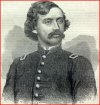 At a lecture, Union Colonel Mulligan described the use of the hemp bales by the Southerners:
At a lecture, Union Colonel Mulligan described the use of the hemp bales by the Southerners:
"The morning of the 20th broke, but no re-enforcements had come; still the men fought on. The rebels appeared that day with an artifice that was destined to overreach us and secure to them the possession of our entrenchments. They had constructed a movable breast-work of hemp bales, rolling them before their lines up the hill, and advanced their artillery under this cover. All our efforts could not retard the advance of these bales. Round shot and bullets were poured against them but they would only rock a little, and then settle back. Heated shots were fired with the hope of setting them on fire, but the enemy had taken the precaution to soak the bales in the Missouri and they would not burn. Thus for hours the fight continued, we striving to knock down or burn their hemp bales, and they striving to knock down our breast-works."
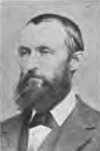 On September 19th according to Missouri State Guard Captain Joseph A Wilson,
On September 19th according to Missouri State Guard Captain Joseph A Wilson,
"[On September 19th,] by Gen. Price's orders, Col. Thomas Hinkle, a wagon boss, hauled a lot of hemp bales from Wellington and they were dumped all along the streets but not taken to the lines until the third day and last day. At the time everybody seemed to give Gen. Price credit for the idea of a movable breast-works, and I think it probable that the idea of rolling them along was Gen. Price's, even if the whole business was not. Gen. Thomas A. Harris, who afterwards became very unfriendly to Price, claimed to have originated the matter. Col. C. Franklin wrote to Gen. Price from Little Rock, in 1863, that Harris claimed it. Col Thomas L. Snead, Price's Adjutant General, heard it suggested by a private in the General's body-guard. Several others claimed it. At first some bales were dipped in the river to protect them from hot shot, but after losing some in the water and trying to roll the wet bales, which drenched men and guns, they used them 'dry so.'
"Two or three men would get behind a bale, roll it awhile, then stop and shoot awhile. A line would be advanced in this way as close as was thought proper, and while the men lay behind and fired, a second line would be rolled up and placed on top of the first. They were not so extensively used as is commonly thought--only in front of the hospital, Anderson's house, and for about two hundred yards on the north. They were very effective in approaching the house, which has heavy brick walls."
Back: Scene of Hand-to-Hand Combat
Next: The Surrender
